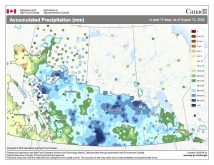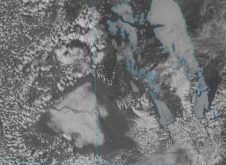TABLE 1 Total rainfall, May 1 to June 27, in millimetres (compared to record)
Dauphin
City
May
June
May and June
Winnipeg Brandon 153.4 (200.6-1999) 107.2 (216.2-2005) 260.6 (272.4-2005)
Regina
Saskatoon
160.0 (177.7-1977) 89.0 (255.7-1901) 249.0 (316.8-1877)
111.2 (133.8-1943) 72.5 (226.7-1944) 183.7 (312.8-1953)
82.3 (160.0-1902) 70.5 (199.2-1975) 152.8 (271.4-1902)
128.5 (147.4-1977) 83.6 (186.5-1942) 212.1 (203.4-1991)
Kindersley 67.2 (223.7-1911) 122.8 (151.1-1956) 190.0 (207.8-1916)
Lethbridge
Calgary
Edmonton
123.0 (286.6-1902) 127.0 (272.0-2005) 250.0 (431.0-1902)
63.8 (156.1-1902)
68.0 (247.6-2005) 131.8 (380.1-1902)
Read Also

What is perfect Christmas weather?
What is ‘perfect’ Christmas weather on the Prairies? Here’s where you should head this holiday, according to historical weather data.
105.9 (184.7-1902) 49.8 (216.5-1914) 155.7 (262.6-1914)
The Weather Vane is prepared by Daniel Bezte, a teacher by profession with a BA (Hon.) in geography, specializing in climatology, from the University of Winnipeg. Daniel has taught university-level classes in climate and weather and currently operates a computerized weather station at his home near Birds Hill Park, on 10 acres he plans to develop into a vegetable and fruit hobby farm.
Contact him with your questions and comments at [email protected].
IInstead of ignoring all of the rain we’ve been getting lately, I figured that instead of running away from my problems maybe I should face them straight on – after all, isn’t that the best way to fix a problem? Maybe if I actually talk about it, all this rain will finally stop and we’ll have that hot dry summer I predicted a couple of months ago!
Yes, I admit, that was the prediction I made, and thanks to several of my faithful readers who haven’t let me forget about it. At least a couple of you were nice enough to pat me on the back for admitting I was wrong and that I was able to poke a little fun at myself. In my defence, however, there are still a couple of months of summer to go and the pattern could just as easily turn back to a dry one, as it did when it went from dry to wet back at the end of April.
So the big question is, just how wet is it? According to some of the maps we’ve been publishing, a good portion of the Prairies has seen near-record to record wetness for the last couple of months. I’m not sure what period of record Agriculture and Agri-Food Canada uses when it creates the maps, comparing current rainfall to past ones, so I figured I would select three cities in each of the Prairie provinces and check out just how much rain has fallen, then look up the records for each of those locations.
Now, I do realize that there have been some areas that have seen much more rain than what these few selected cities received, but it is a daunting task to collect data and then find reliable long-term records for every site across the Prairies. Hopefully the sites selected will be able to capture the general picture of rainfall across the Prairies.
Interestingly, when I went through all of the data for my selected sites, I only found one site that had broken a rainfall record for the period of May and June, and that was Saskatoon. I also discovered that while we are really wet this year, historically the Prairies have seen some even wetter times.
Table 1 is a table of rainfall for the months of May and June (up to June 27) along with the totals for those two months (I know there a still a few days left in June). In brackets I have included the records along with the year. All values are in millimeters.
These are some impressive but rather scary totals! I can’t imagine what 431 mm falling in May and June in Lethbridge back in 1902 would have been like. In fact, the year 1902 was a really wet late spring and early summer, at least for the western Prairies, as most of the rainfall records for this part of the year come from 1902. When I saw this data I naturally had to take a closer look at 1902. I discovered the spring of 1902 had started off much like this year, with a fairly warm and dry April. Then the skies opened up and it rained like crazy in all three Prairie provinces in May. During June the rains kept falling heavily in Alberta, but lessened in Saskatchewan and Manitoba. By the time July and August rolled around, rainfall slacked off a bit in Alberta and it actually became fairly dry in Saskatchewan and Manitoba.
I realize that knowing it was once even wetter than it is now doesn’t help much when you are watching your crops slowly die off or you simply can’t get onto the land to do anything, but as we have seen in the past, this wet period will come to an end and things will eventually dry out. Unfortunately for some of us, the dry weather, when it comes, will not be enough to salvage the year. An interesting question we have to start asking ourselves is whether the wet springs the Prairies have seen of late is simply part of a natural wet cycle, or are we seeing a shift in the overall weather pattern? It’s still too early to tell, but I’m sure hoping it’s not the latter!















